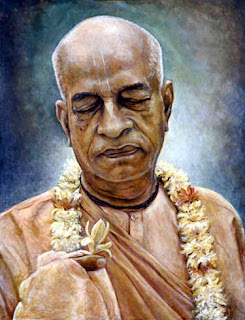The Eightfold Path of Yoga, Eightfold Noble Path of Buddha, and the Ninefold Path of Surrender:
By Michael Dolan, B.V. Mahayogi
Steps to Self-Realization
The Bhagavad Gita and Yoga Sutras of Patanjali
Yoga is popular nowadays. In your local supermarket you will find advertisements for everything from integral yoga to naked yoga, flying yoga, even dancing yoga.
The word “Yoga” is interesting. In a sense, it really means “to join,” since the root of the word in Sanskrit is yoj. The English word “yoke” is derived from the same root as is yojana, the Vedic unit of measure which literally means a “day’s journey by oxen.” The oxen are yoked together in a team. So joining or union. Any practice which advances our union with divinity is a form of yoga.
Karma, jñāna, aṣṭāṇga and
bhakti. These are the four approaches to divinity.
 |
| Practicing "Good Karma" or Right Action is a form of Yoga |
Karma-yoga attempts to realize salvation through perfect action. One who knows the laws of cause and effect, of action and reaction realizes that bad action has consequences and seeks to purify action by avoiding sin and accepting piety. One strives for perfection through proper action and good deeds. Ethical action is the basis of many religions.
 |
| Ethical action or "good karma" is the basis of many religions |
Others find that
karma is superficial. Action alone will not gain salvation. The soul exists on a plane above the material forces of action and reaction. Spiritual knowledge is required for a more perfect union with God. Such a yoga path is called
jñāna, or knowledge.
 |
| Jñāna or knowledge is another form of Yoga practice |
In English, the word
gnosis is close to the meaning of
jñāna (pronounced
gyan).
Bhakti is the
yoga recommended by Krishna as the Supreme Yoga. He explains that it is through love of God that we achieve the most perfect union.
Still others are attracted to the mystic yoga path called
aṣṭāṇga, or the eightfold path, best outlined by Patanjali centuries after Krishna spoke the Bhagavad-Gita on the plains of Kurukshetra before the dawn of the Kali age.
 |
| The eight-fold path of Yoga appeals to many |
The eight-fold path consists of systematic and definite steps to realization of our own spiritual energy as the atma within as a precursor to realization of the higher divinity above and beyond, called Paramatma.
The essence of this yoga path was set forth in systematic form by the ancient sage Patanjali in his short but masterly work, the Yoga Sutras.
Paramahansa Yogananda has written: “Patanjali’s date is unknown, though many scholars assign him to the second century B.C. His renowned Yoga Sutras presents, in a series of brief aphorisms, the condensed essence of the exceedingly vast and intricate science of [Yoga] in such a beautiful, clear, and concise way that generations of scholars have acknowledged the Yoga Sutras as the foremost ancient work on yoga.”
The yoga system of Patanjali is known as the Eightfold Path, which leads to the final goal of God-realization. Krishna’s Bhagavad-Gita outlines the principles of Astanga yoga long before Patanjali in the sixth Chapter. This yoga is in part a mechanical meditative practice, which seeks to control the mind and senses and focuses with concentration on Paramatma (the Supersoul, the form of the Lord situated in the heart) as the goal.
Ashtanga-yoga culminates in
samadhi, full consciousness of the individual soul as consciousness and the Supreme Soul as the Paramatma or supreme higher consciousness.
 |
| Christ in Samādhi |
Patanjali’s Eightfold Path of Yoga sets forth eight principles. All of these principles are valuable in discovering the self and making progress on the path of self-realization. Westerners generally are exposed to the idea of
asanas or different yoga postures.
 |
| Mystic Yogi |
This is an important part of Patanjali’s system for fine-tuning body and mind, and so we may place it at the beginning of our list. The Eight principles of
Ashtanga-yoga are as follows:
1. Asana: right posture.
2. Yama (avoidance of negative moral conduct): noninjury to others, truthfulness, nonstealing, continence, and noncovetousness
3. Niyama (appropriate moral conduct, following the rules and principles of dharma): purity of body and mind, contentment in all circumstances, self-discipline, self-study (contemplation), and devotion to God and guru.
4. Pranayama: Breath control and exercises. The control of prana, the subtle life currents in the body, is important in self-realization, since it improves mindfulness.
5. Pratyahara: Controlling the mind by withdrawing the senses from the sense objects.
6.
Dharana: focused concentration; arresting the mind from drifting from one thing to the next. Krishna explains, “For him who has conquered the mind, the mind is the best of friends; but for one who has failed to do so, his very mind will be the greatest enemy.”
bandhur ātmātmanas tasya yenātmaivātmanā jitaḥ anātmanas tu śatrutve vartetātmaiva śatru-vat|| बन्धुर् आत्मात्मनस् तस्य येनात्मैवात्मना जितः । अनात्मनस् तु शत्रुत्वे वर्तेतात्मैव शत्रु-वत्॥(BG 6.6)
In his purport to this verse Śrīla Prabhupāda points out: “The purpose of practicing eightfold
yoga is
to control the mind in order to make it a friend in discharging the human mission. Unless the mind is controlled, the practice of
yoga (for show) is simply a waste of time. One who cannot control his mind lives always with the greatest enemy, and thus his life and its mission are spoiled. The constitutional position of the living entity is to carry out the order of the superior. As long as one's mind remains an unconquered enemy, one has to serve the dictations of lust, anger, avarice, illusion, etc.
"But when the mind is conquered, one voluntarily agrees to abide by the dictation of the Personality of Godhead, who is situated within the heart of everyone as Paramatma. Real
yoga practice entails meeting the Paramatma within the heart and then following His dictation. For one who takes to Krsna consciousness directly, perfect surrender to the dictation of the Lord follows automatically.”
7. Dhyana: meditation, absorption in the vast perception of God.
8. Samadhi: superconscious experience of the individualized soul and its relationship with the Supersoul or Paramātma.
Samādhi has been defined by Krishna as follows: jñāna-vijñāna-tṛptātmā kūṭa-stho vijitendriyaḥ yukta ity ucyate yogī sama-loṣṭrāśma-kāñcanaḥ
ज्ञान-विज्ञान-तृप्तात्मा कूट-स्थो विजितेन्द्रियः युक्त इत्य् उच्यते योगी सम-लोष्ट्राश्म-काञ्चनः “For one who has conquered the mind, the Supersoul is already reached, for he has attained tranquility. To such a man happiness and distress, heat and cold, honor and dishonor are all the same.”
Śrīla Prabhupāda notes Krishna is defining the idea of
samādhi here by his use of the world “
sama”...”The effect of controlling the mind is that one automatically follows the dictation of the Paramatma or Supersoul. Because this transcendental position is at once achieved by one who is in Krsna consciousness, the devotee of the Lord is unaffected by the dualities of material existence, namely distress and happiness, cold and heat, etc. This state is practical
samadhi, or absorption in the Supreme.”
 |
| Lord Shiva in Samādhi |
It is important to note that the Patanjali tradition flows from the truths revealed in the Bhagavad-Gita and that Patanjali could hardly have defined samādhi differently from Krishna. If his followers have done so, they should return to the original meaning expressed in the sutras. In the next verse, Krishna further defines samādhi as a state of perfect intelligence, by which one sees everything in harmony:
suhṛn mitrāry-udāsīna madhyastha-dveṣya-bandhuṣu sādhuṣv api ca pāpeṣu sama-buddhir viśiṣyate
“A person is said to be still further advanced when he regards all—the honest well-wisher, friends and enemies, the envious, the pious, the sinner and those who are indifferent and impartial—with an equal mind.” (
samabuddhi). Here, Krishna identifies harmonic vision with the perfect intelligence of
samādhi, explaining that a perfectly realized soul sees everything on the spiritual platform.
If Patanjali’s eightfold path was defined somewhere between the Second and Fourth Century in India, it was inevitably influenced by the prevalence of Buddhism. It was not until after Shankaracharya’s Vedanta commentary in the 8th Century that Buddhism began losing popularity on the Indian Subcontinent.
 |
| Adi Shankar Acharya |
Shankar Acharya sharply criticized the unscrupulous practices of monks, bringing about a reform in Buddhist monasteries. So, if Patanjali had written his sutras during the height of Buddhist influence in India, it may be enlightening to compare his eightfold path with that of the Buddhists.
While the yogic eightfold path seems to concentrate on personal enlightenment to the exclusion of real ethical considerations, the Buddha’s eightfold path appears to have a more universal application. It may be noted that neither of the two approaches attempt to incorporate “religious” considerations, but strive for universal truth.

Buddha, often considered an incarnation of Vishnu for the purpose of promoting the philosophy of nonviolence, discovers four universal truths.
Buddha begins by addressing the most important problems of human existence: birth, death, old age, and disease. Throughout our entire lifetime we are plagued by different miseries. There are problems beyond human control, for example, floods, drought, plague, and famine. There are problems caused by other people or even animals and mosquitoes. Then there are the miseries caused by our own body and mind. In short, there is suffering.
This is Buddha’s first “Noble Truth.” There is suffering. No one can dispute this.
His second idea is to analyse why there is suffering. His conclusion is that suffering is based on desire. As long as we want something we don’t have, we will be unhappy and suffer. His idea is beautiful in its simplicity. So far there is nothing intellectual or ontological about his curiosity. His question merely locates the central problem of our existence: Suffering. Then he asks, “Why do we suffer?” and concludes that the root of suffering is desire.
But the next question that comes up is “Where does desire come from?” If we suffer because we desire, then what is the origin of this desire? Is it possible to quench desire? Can desire be satiated? Buddha reaches the same conclusion as did the Rolling Stones: “I can’t get no satisfaction.”
Desire, according to Buddha, seems to be based on Ego. As long as there is an “I” there must be desire. Never mind the ontological nature of the soul. We don’t seem to be in a position to grasp that at this point. But we can say that the desire caused by Ego is at the heart of our suffering. This is his third Noble truth: Ego causes desire.
So Buddha sets out to see how Ego can be dealt with. His plan for dealing with Ego is called the “Path.” And this is his fourth Noble truth: the “path” to release the Ego.
Now, Buddhism tends towards nihilism and voidism. Nirvana is an interesting word in Sanskrit. Nir means “not” or Nothing. Vana means “forest” and by extension any inhabitable place. So Nirvana really means “Nowhere.” It was Samuel Butler who turned Utopia on its head by writing his satire Erewhon, which is Nowhere spelled backwords. The very idea of Buddhism is to get us to Nowhere, nirvana, since anywhere must be better than this world of suffering and loss.
But leaving aside this negative aspect of Buddhist philosophy, there is something integral about Buddha’s ideas that have given comfort to humanity for 25 centuries. Patanjali liked the eightfold path enough that he adopted it in his own Yoga system. Did Patanjali borrow the eightfold path from Buddha? Or did Buddha steal the eightfold path from Krishna. Perhaps he read the Bhagavad-Gita in secret and plagiarized Krishna, hoping that he would never be discovered. Or, then again, isn’t it possible that there is a universal truth embedded in the eight-fold path, one that we might profit by studying.
If Krishna, Buddha, and Patanjali forwarded the same idea with a slightly different focus, perhaps we might benefit by looking more closely at the eightfold path.
Buddha claims that there are four important ideas or truths that we must take as being axiomatic:
1. There is suffering.
2. Suffering is caused by desire.
3. Desire flows from the Ego.
4. We must then investigate how to escape Ego using the 8-fold path.
So far so good. There may be different approaches to resolving the problem of Ego, depending on our sense of ontology, that is to say, “who we are.”
But let’s take a closer look: Having established his Four Noble Truths, Buddha goes on to describe his process, his “eight-fold path” to dissolve the ego and reach nirvana.
Buddha’s eightfold path may be divided into 3 parts: perspective, action, and mindfulness.
Perspective is the beginning. The first step on the path is to begin to understand the ego, to do some self-analysis and introspection. Buddha calls this first step “Right vision.” In Sanskrit this is called samyak drishti. The word samyak is often translated as “right,” so Right Vision.
But samyak also means “complete,” as in saṅkirtan, which means “complete kirtan.” Samyak carries the sense of total, complete, wholistic. And dristhi or darshan means “vision, perspective, point of view, philosophy.
Before setting out on the path to enlightenment, on should have the proper perspective, a complete vision of the gestalt or total reality. If one sees reality with spiritual vision, one’s action, speech and thinking will flow in harmony with this awareness of reality.
The correct perspective allows us to act in proper adjustment. Buddha asks us to keep in mind that the world is temporary. That death is imminent. The temporal nature of reality and the imminence of death should lead us toward the truth about the self. Buddha understands that by giving up attachment to material things we lose desire for them and so become free from suffering.
Lord Buddha calls the second step on the path samyak samkalpa, which is generally taken to mean Right Intention. saṅkalpa means determination, or one’s proper conviction after due diligence. Complete or firm determination. This may be considered a precursor to faith: Proper intention, purity of conviction. One is determined to reach freedom from false ego and selfishness, acting with compassion and benevolence to reach the goal.
The third step on the eightfold path brings us into practice. If the first two ideas have to do with perspective and conviction, the third has to do with action.
The third step on the eightfold path is called “Right Speech.” samyak vac. Again samyak may be translated as perfect. So Perfect Speech. This is not the same as the perfect tense in English.
Perfect Speech means freedom from gossip and fault-finding. You might define it as a rigorous distance from false and hurtful speech and gossip: avoid speech that offends; speak the truth. Speak sweetly. Avoid speaking harsh truths that offend. Be honest. There is an echo of Buddha’s teaching in Rupa Goswami’s Upadeshamrita where he calls for his followers to control the urge to speak vāco vegaṁ manasaḥ krodha-vegaṁ jihvā-vegam udaropastha-vegam etān vegān yo viṣaheta dhīraḥ sarvām apīmāṁ pṛthivīṁ sa śiṣyāt.
वाचो वेगं मनसः क्रोध-वेगं जिह्वा-वेगम् उदरोपस्थ-वेगम् एतान् वेगान् यो विषहेत धीरः सर्वाम् अपीमां पृथिवीं स शिष्यात्.
“One who can control the forces of speech, mind, anger, belly, tongue and genitals is known as a gosvāmī and is competent to accept disciples all over the world.” Upadeshamrita 1, (Nectar of Instruction, Rupa Goswami.)
Buddha tells us to control our speech, to speak carefully and completely: Samyak vak . This principle perhaps did not originate with Buddha thousands of years ago, but it has been accepted as a valuable truth and incorporated into the monastic traditions of spiritual communities wherever people practice meditation and prayer. An extreme example would be the Trappist monks who follow a strict version of the vows of silence as set down in the Rule of St. Benedict.
The practical aspects of the eightfold path begin with speech and continue with action. Buddha identifies three different aspects of action: Action itself, Livelihood, and Sincere Effort.
Action means acting appropriately. Since suffering is the basic truth of reality, we should not cause more suffering. Any suffering we create will come back to us as the law of karma. Therefore we must act appropriately in avoiding all kinds of violence to others including stealing which is violence against property. Murder and meat-eating are other forms of violence. Violence creates a negative karmic reaction and upsets the balanced life that a truth-seeker strives for. By the same token one must avoid immoral conduct such as adultery, fornication, prostitution, and all forms of sexual misconduct. Intoxication ruins the capacity for proper vision and intention and must be forsaken. Drug addiction and drunkenness it all its forms destroys the prospects for self-realization. Gambling agitates the mind as well. Sharp and ruinous business practices are also actions to be avoided. Acting appropriately is called Right Action.
The 5th step is Right Livelihood. Avoiding negative action is insufficient to bring about a balanced life of harmony, according to the teachings of the Buddha. One must have a proper occupation. This includes education and proper thinking. By living a balanced life one reduces egotism. Unsuitable occupations include working as a butcher or a wine merchant. Suitable occupations are honest and nonviolent and contribute something to society. Right Livelihood means living according to your principles by accepting a proper occupation. These are universally accepted principles for living.
The fifth step on the eightfold path is called Right Effort, samyak vyayam. Vyayam means “exercise” If we take this in the sense of physical exercise, then this corresponds to the asana part of the eightfold yoga path of Patanjali. But here, exercise is not only physical but mental and refers to the proper exercise of the above principles.
So far we have seen certain parallels with Patanjali’s eightfold path. Yama and Niyama or accepting what is favorable rules and regulations and rejecting unfavorable behavior are reflected in Buddha’s ideas about practical behavior and action. Dharana and Dhyana correspond to meditation and conduct. Buddha lays no emphasis on Pranayama as such, but Pranayama breathing exercises are practiced in many Buddhist circles. Pratyahara or properly controlling the mind, giving up negative ideas also corresponds to some extent to this concept of proper exercise, which flows through the sixth step, called Right Effort.
The Sixth step is called Right Effort or pro-active vigilance against unwholesome mental thoughts, evil ideas and attitudes, mental vices such as lust, greed, sloth, pride, illusion, envy, racism, nationalism, materialism, sensualism, and other forms of egoism.
Having contemplated different aspects of action both subtle and gross, in speech and deed, Buddha moves on to consider the nature of the mind. The 7th step on the eightfold path is called samyak smrti. In Sanskrit smrti means “memory.”
For Buddhists, smriti means to maintain a proper consciousness of body, mind, and spirit, remembering the four noble truths and what has been learned by following the eight-fold path. By remembering the imminence of death and the impermanence of the world followers of Buddha’s path try to maintain proper adjustment.
Followers of Krishna consciousness, Vaishnavas, find this to be an incomplete version of rememberance. After all, Buddha is calling for samyak smriti or total recall.
What then is the best smrti? The best remembrance is to remember Krishna. While Buddha advises his followers to follow the eightfold path to enlightenment, Vaishnavas have a nine-fold path of surrender:
śrī-prahrāda uvāca śravaṇaṁ kīrtanaṁ viṣṇoḥ smaraṇaṁ pāda-sevanam arcanaṁ vandanaṁ dāsyaṁ sakhyam ātma-nivedanam iti puṁsārpitā viṣṇau bhaktiś cen nava-lakṣaṇā kriyeta bhagavaty addhā tan manye ’dhītam uttamam
श्री-प्रह्राद उवाच श्रवणं कीर्तनं विष्णोः स्मरणं पाद-सेवनम् अर्चनं वन्दनं दास्यं सख्यम् आत्म निवेदनम् इति पुंसार्पिता विष्णौ भक्तिश् चेन् नव-लक्षणा क्रियेत भगवत्य् अद्धा तन् मन्ये ’धीतम् उत्तमम्
Prahlāda Mahārāja said: Hearing and chanting about the transcendental holy name, form, qualities, paraphernalia and pastimes of Lord Viṣṇu, remembering them, serving the lotus feet of the Lord, offering the Lord respectful worship with sixteen types of paraphernalia, offering prayers to the Lord, becoming His servant, considering the Lord one’s best friend, and surrendering everything unto Him (in other words, serving Him with the body, mind and words)—these nine processes are accepted as pure devotional service. One who has dedicated his life to the service of Kṛṣṇa through these nine methods should be understood to be the most learned person, for he has acquired complete knowledge.
(SB 7.5.23-24 Śrīla Prabhupāda)
Smaranam or Smriti remembrance is an important aspect of surrender. Note here that the 9 different kinds of surrender are not a means towards an ends as are the eightfold steps of Buddha’s enlightenment. It is not that by following the different processes of surrender that we gain freedom from misery. The processes of surrender are not a means towards an ends but an ends in themselves. Surrender is its own reward. The goal of bhakti is love. Love is its own reward.
In any case, smaranam, or remembrance, according to the Vaishnavas is remembrance of God, not of the misery and suffering of this world or the need to destroy the ego. In this sense there is a big difference between Buddha’s path and Vaishnava faith.
How is remembrance achieved? This may be done through repetition of the mantra while remembering its inner sense. Guru has given us the mantra as a means to remember Krishna. By constantly meditating on the mantra we come into connection with that memory. REmembering Krishna is real samyak smrti, that is, proper memory.
The next step in Buddha’s eight-fold path is samādhi, which according to his analysis is perfect concentration or mindfulness, enlightenment.
Vaishnavas have a different perspective on samādhi, one which is at variance as well with that of Patanjali. The Vaishnava acharyas consider that one who is well-established in remembrance of Krishna enters into the divine domain. His situation there in samyak smrti, as one who never forgets the Lord, is called samadhi. Established in complete remembrance or samyak smrti, the devotee who has realized his position as an eternal servitor of divinity realizes complete bliss. This is samyak or complete samādhi according to the Vaishnava Acharyas.
As we have seen there are certain parallels between the ancient system of ashtanga yoga as outlined by Patanjali and the eight-fold approach to enlightenment as outlined by Lord Buddha.
These principles adhere to a certain set of truths that cannot be denied, insofar as they have guided the lives of spiritual aspirants in various countries over a period of thousands of years.
The special distinction held by the Vaishnava way of life is to incorporate these ideas into the daily life of sadhakas who follow the guidelines laid out by guru in the line of Śrī Caitanya. The advice that has been followed by both yogis and practicioners of Buddhas has been useful in focusing the mind, restraining the lower impulses and guiding ethical and practical behavior in the search for enlightenment.
Where Buddha stressed a search for truth, Shankar and Patanjali aimed higher at eternal spiritual realization. The Vaishnava contribution is the Search for Shri Krishna, the search for eternal bliss in a loving relationship with God, Krishna that can be attained not only by following the principles of an eight-fold path, but through the mercy of guru and Krishna.
But while we hold out for the mercy of guru and Krishna like the chataka bird who stretches his beak out to the heavens for rain, we do not deny the practice of ethical spiritual principles. The idea of Right Thinking, Right Action, and Right Speech while forwarded milennium ago by Buddha is still useful today. The principles of compassion and nonviolence are not absolutes: Divine mercy is the highest absolute. But in the search for personal realization following the above principles is good advice for any spiritual aspirant. One must strictly adhere to these fundamental principles to purify the body, mind, and spirit in the search for Sri Krishna.




























































